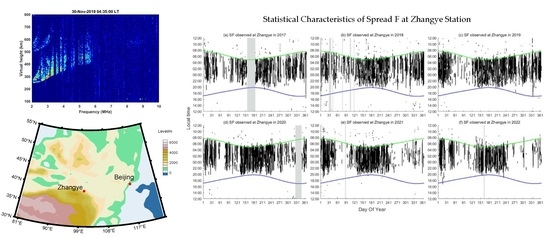Statistical Characteristics of Spread F in the Northeastern Edge of the Qinghai-Tibet Plateau during 2017–2022
Abstract
:1. Introduction
2. Data and Methodology
3. Result
3.1. Diurnal and Seasonal Variations of Spread F
3.2. Dependence of Solar and Geomagnetic Activity
4. Discussion
5. Conclusions
- (1)
- Statistical results show that the diurnal, seasonal and solar activity variations are consistent with previous studies. The maximum occurrence rates of SF are mostly during post-midnight. As for seasonal variation, the occurrence probabilities of SF are higher in summer and winter, and the highest value is in summer (except 2019). In this study, there is a negative relationship between solar activity and SF. However, the relationship between SF and geomagnetic condition might depend on the specified season and local time.
- (2)
- We found that there are several anomalies for the occurrence rate of SF in this study. First, the occurrence probabilities of SF are higher than other mid-latitude stations (Beijing station). Second, the occurrence probabilities of SF are abnormal higher in autumn and winter from 2017 to 2020, but lower in 2021 and 2022 (except January 2021).
- (3)
- The anomalies mentioned above might be attributed to gravity waves in the northeast of the Qinghai-Tibet Plateau and the effect of solar activity. Gravity waves in the Qinghai-Tibet Plateau are more active in autumn and winter which might cause the higher occurrence probability of SF. The solar activity might have an influence on gravity waves, which lead to the lower occurrence probabilities of SF in 2021 and 2022.
Author Contributions
Funding
Data Availability Statement
Acknowledgments
Conflicts of Interest
References
- Abdu, M.A.; Muralikrishna, P.; Batista, I.S.; Sobral, J.H.A. Rocket observation of equatorial plasma bubbles over Natal, Brazil, using a high-frequency capacitance probe. J. Geophys. Res. Space Phys. 1991, 96, 7689–7695. [Google Scholar] [CrossRef]
- Booker, H.G.; Wells, H.W. Scattering of radio waves by the F-region of the ionosphere. Terr. Magn. Atmos. Electr. 1938, 43, 249–256. [Google Scholar] [CrossRef]
- Perkins, F. Spread F and ionospheric currents. J. Geophys. Res. 1973, 78, 218–226. [Google Scholar] [CrossRef]
- Bowman, G.G. A review of some recent work on mid-latitude spread-F occurrence as detected by ionosondes. J. Geomagn. Geoelectr. 1990, 42, 109–138. [Google Scholar] [CrossRef]
- Paul, K.S.; Haralambous, H.; Oikonomou, C.; Singh, A.K.; Gulyaeva, T.L.; Panchenko, V.A.; Altadill, D.; Buresova, D.; Mielich, J.; Verhulst, T. Mid-latitude spread F over an Extended European area. J. Atmos. Sol. Terr. Phys. 2023, 248, 106093. [Google Scholar] [CrossRef]
- Xu, S.; Yue, J.; Xue, X.; Vadas, S.L.; Miller, S.D.; Azeem, I.; Straka, W., III; Hoffmann, L.; Zhang, S. Dynamical coupling between Hurricane Matthew and the middle to upper atmosphere via gravity waves. J. Geophys. Res. Space Phys. 2019, 124, 3589–3608. [Google Scholar] [CrossRef]
- Kelley, M.C.; Haldoupis, C.; Nicolls, M.J.; Makela, J.J.; Belehaki, A.; Shalimov, S.; Wong, V.K. Case studies of coupling between the E and F regions during unstable sporadic-E conditions. J. Geophys. Res. 2003, 108, 1447. [Google Scholar] [CrossRef]
- Jiang, C.; Wei, L.; Yang, G.; Aa, E.; Lan, T.; Liu, T.; Liu, J.; Zhao, Z. Large-Scale Ionospheric Irregularities Detected by Ionosonde and GNSS Receiver Network. IEEE Geosci. Remote Sens. Lett. 2021, 18, 940–943. [Google Scholar] [CrossRef]
- Paulikas, G.A. Precipitation of particles at low and middle latitudes. Rev. Geophys. 1975, 13, 709–734. [Google Scholar] [CrossRef]
- Dabas, R.S.; Das, R.M.; Sharma, K.; Garg, S.C.; Devasia, C.V.; Subbarao, K.S.V.; Rama, R.P.V.S. Equatorial and low latitude spread-F irregularity characteristics over the Indian region and their prediction possibilities. J. Atmos. Sol. Terr. Phys. 2007, 69, 685–696. [Google Scholar] [CrossRef]
- Huang, W.Q.; Xiao, Z.; Xiao, S.G.; Zhang, D.H.; Hao, Y.Q.; Suo, Y.C. Case study of apparent longitudinal differences of spread F occurrence for two midlatitude stations. Radio Sci. 2011, 46, 1–8. [Google Scholar] [CrossRef]
- Paul, K.S.; Haralambous, H.; Singh, A.K.; Gulyaeva, T.L.; Panchenko, V.A. Mid-latitude Spread F long-term occurrence characteristics as a function of latitude over Europe Adv. Space Res. 2022, 70, 710–722. [Google Scholar] [CrossRef]
- Guo, B.; Xiao, S.G.; Shi, J.K.; Xiao, Z.; Wang, G.J.; Cheng, Z.W.; Shang, S.P.; Wang, Z.; Suo, Y.C. Comparative study on characteristics of spread-F at low and mid-latitudes during high and low solar activities over East Asia. Chinese J. Geophys. 2017, 60, 3289–3300. (In Chinese) [Google Scholar]
- Wang, Y.G.; Mao, T.; Lü, J.; Mei, D. Characteristics of spread-F occurrence in China region in low solar cycle. Prog. Geophys. 2020, 35, 0050–0054. (In Chinese) [Google Scholar] [CrossRef]
- Igarashi, K.; Kato, H. Solar Cycle Variations and Latitudinal Dependence on the Mid-Latitude Spread-F Occurrence around Japan; XXIV General Assembly: Kyoto, Japan, 1993. [Google Scholar]
- Paul, K.S.; Haralambous, H.; Oikonomou, C.; Paul, A.; Belehaki, A.; Ioanna, T.; Kouba, D.; Buresova, D. Multi-station investigation of spread F over Europe during low to high solar activity. J. Space Weather Space Clim. 2018, 8, A27. [Google Scholar] [CrossRef]
- Bhaneja, P.; Earle, G.D.; Bishop, R.L.; Bullett, T.W.; Mabie, J.; Redmon, R. A statistical study of midlatitude spread F at Wallops Island, Virginia. J. Geophys. Res. 2009, 114, A04301. [Google Scholar] [CrossRef]
- Wan, W.; Yuan, H.; Ning, B.; Liang, J.; Ding, F. Traveling ionospheric disturbances associated with the tropospheric vortexes around Qinghai-Tibet Plateau. Geophys. Res. Lett. 1998, 25, 3775–3778. [Google Scholar] [CrossRef]
- Jiang, C.; Yang, G.; Zhou, Y.; Zhu, P.; Lan, T.; Zhao, Z.; Zhang, Y. Software for scaling and analysis of vertical incidence ionograms-ionoScaler. Adv. Space Res. 2017, 59, 968–979. [Google Scholar] [CrossRef]
- Reinisch, B.W.; Galkin, I.A.; Khmyrov, G.M.; Kozlov, A.V.; Lisysyan, I.A.; Bibl, K.; Cheney, G.; Kitrosser, D.F.; Stelmash, S.; Roche, K.; et al. Advancing Digisonde technology: The DPS-4D, in Radio Sounding and Plasma Physics. AIP Conf. Proc. 2008, 974, 127–143. [Google Scholar] [CrossRef]
- Piggott, W.R.; Rawer, K.U.R.S.I. Handbook of Ionogram Interpretation and Reduction; World Data Center A for Solar-Terrestrial Physics NOAA: Boulder, CO, USA, 1972; pp. 17–18. [Google Scholar]
- Katamzi-Joseph, Z.T.; Habarulema, J.B.; Hernández-Pajares, M. Midlatitude postsunset plasma bubbles observed over Europe during intense storms in April 2000 and 2001. Space Weather 2017, 15, 1177–1190. [Google Scholar] [CrossRef]
- Chandra, H.; Rastogi, R.G. Equatorial spread-F over a solar cycle. Ann. Geophys. 1972, 28, 709–716. [Google Scholar]
- Bowman, G.G. Short-term delays in ionogram-recorded equatorial spread F occurrence of equatorial spread F. Ann. Geophys. 1995, 11, 624–663. [Google Scholar]
- Wang, G.J.; Shi, J.K.; Wang, X.; Shang, S.P.; Zherebtsov, G.; Pirog, O.M. The statistical properties of spread F observed at Hainan station during the declining period of the 23rd solar cycle. Ann. Geophys. 2010, 28, 1263–1271. [Google Scholar] [CrossRef]
- Su, S.Y.; Liu, C.H.; Ho, H.H.; Chao, C.K. Distribution characteristics of topside ionospheric density irregularities: Equatorial versus midlatitude regions. J. Geophys. Res. 2006, 111, A06305. [Google Scholar] [CrossRef]
- Cosgrove, R.B.; Tsunoda, R.T. Instability of the E-F coupled nighttime midlatitude ionosphere. J. Geophys. Res. 2004, 109, A04305. [Google Scholar] [CrossRef]
- Zhou, C.; Tang, Q.; Huang, F.; Liu, Y.; Gu, X.; Lei, J.; Ni, B.; Zhao, Z. The simultaneous observations of nighttime ionospheric E region irregularities and F region mediumscale traveling ionospheric disturbances in midlatitude China. J. Geophys. Res. Space Phys. 2018, 123, 5195–5209. [Google Scholar] [CrossRef]
- Wang, W.; Jiang, C.; Wei, L.; Tang, Q.; Huang, W.; Shen, H.; Liu, T.; Yang, G.; Zhou, C.; Zhao, Z. Comparative Study of the Es Layer between the Plateau and Plain Regions in China. Remote Sens. 2022, 14, 2871. [Google Scholar] [CrossRef]
- Kelley, M.C.; Fukao, S. Turbulent upwelling of the mid-latitude ionosphere: 2. Theoretical framework. J. Geophys. Res. 1991, 96, 3747–3753. [Google Scholar] [CrossRef]
- Bowman, G.G. Spread-F in the ionosphere and the neutral particle density of the upper atmosphere. Nature 1964, 201, 564–566. [Google Scholar] [CrossRef]
- Hines, C.O. The upper atmosphere in motion. Q. J. R. Meteorol. Soc. 1963, 89, 1–42. [Google Scholar] [CrossRef]
- Zeng, X.; Xue, X.; Dou, X.; Liang, C.; Jia, M. COSMIC GPS observations of topographic gravity waves in the stratosphere around the Tibetan Plateau. Sci. China Earth Sci. 2017, 60, 188–197. [Google Scholar] [CrossRef]
- Medvedev, A.S.; Gavrilov, N.M. The nonlinear mechanism of gravity wave generation by meteorological motions in the atmosphere. J. Atmos. Terr. Phys. 1995, 57, 1221–1231. [Google Scholar] [CrossRef]
- Mandal, S.; Pallamraju, D.; Karan, D.K.; Phadke, K.A.; Singh, R.P.; Suryawanshi, P. On deriving gravity wave characteristics in the daytime upper atmosphere using radio technique. J. Geophys. Res. Space Phys. 2019, 124, 6985–6997. [Google Scholar] [CrossRef]
- Kotake, N.; Otsuka, Y.; Ogawa, T.; Tsugawa, T.; Saito, A. Statistical study of medium-scale traveling ionospheric disturbances observed with the GPS networks in Southern California. Earth Planet Spaces 2007, 59, 95–102. [Google Scholar] [CrossRef]
- Igi, S.; Minakoshi, H.; Yoshida, M. Automatic ionogram processing system. II: Automatic ionogram scaling. J. Commun. Res. Lab. 1992, 39, 367–379. [Google Scholar]
- Jiang, C.; Yang, G.; Zhao, Z.; Zhang, Y.; Zhu, P.; Sun, H. An automatic scaling technique for obtaining F2 parameters and F1 critical frequency from vertical incidence ionograms. Radio Sci. 2013, 48, 739–751. [Google Scholar] [CrossRef]
- Lynn, K.J. Histogram-based ionogram displays and their application to autoscaling. Adv. Space Res. 2018, 61, 1220–1229. [Google Scholar] [CrossRef]
- Qian, T.; Zhang, F.; Wei, J.; He, J.; Lu, Y. Diurnal Characteristics of Gravity Waves over the Tibetan Plateau in 2015 Summer Using 10-km Downscaled Simulations from WRF-EnKF Regional Reanalysis. J. Atmos. 2020, 11, 631. [Google Scholar] [CrossRef]
- Vadas, S.L. Horizontal and vertical propagation and dissipation of gravity waves in the thermosphere from lower atmospheric and thermospheric sources. J. Geophys. Res. 2007, 112, A06305. [Google Scholar] [CrossRef]
- Liu, X.; Yue, J.; Xu, J.; Garcia, R.R.; Russell, J.M., III; Mlynczak, M.; Wu, D.L.; Nakamura, T. Variations of global gravity waves derived from 14 years of SABER temperature observations. J. Geophys. Res. Atmos. 2017, 122, 6231–6249. [Google Scholar] [CrossRef]
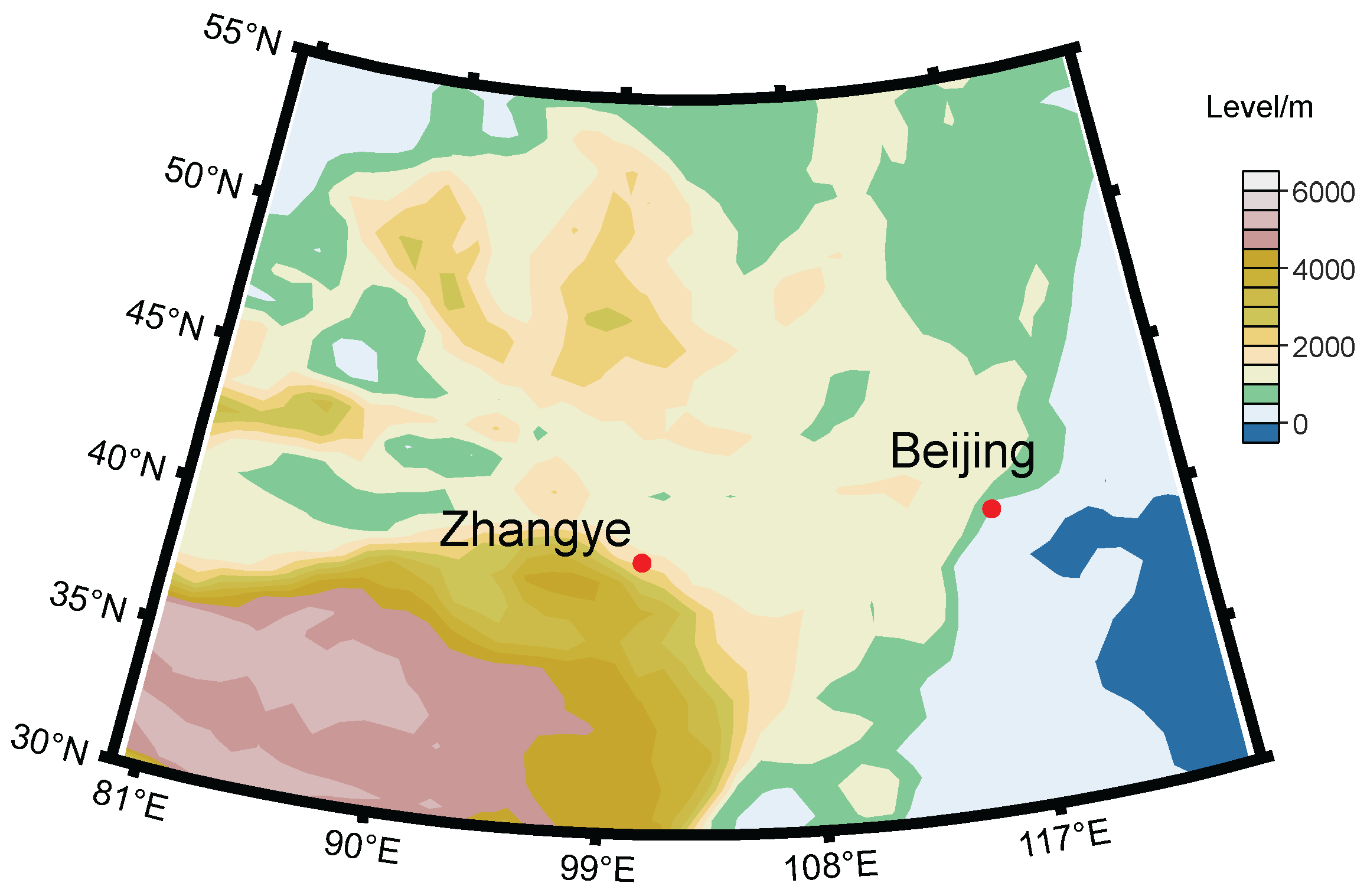
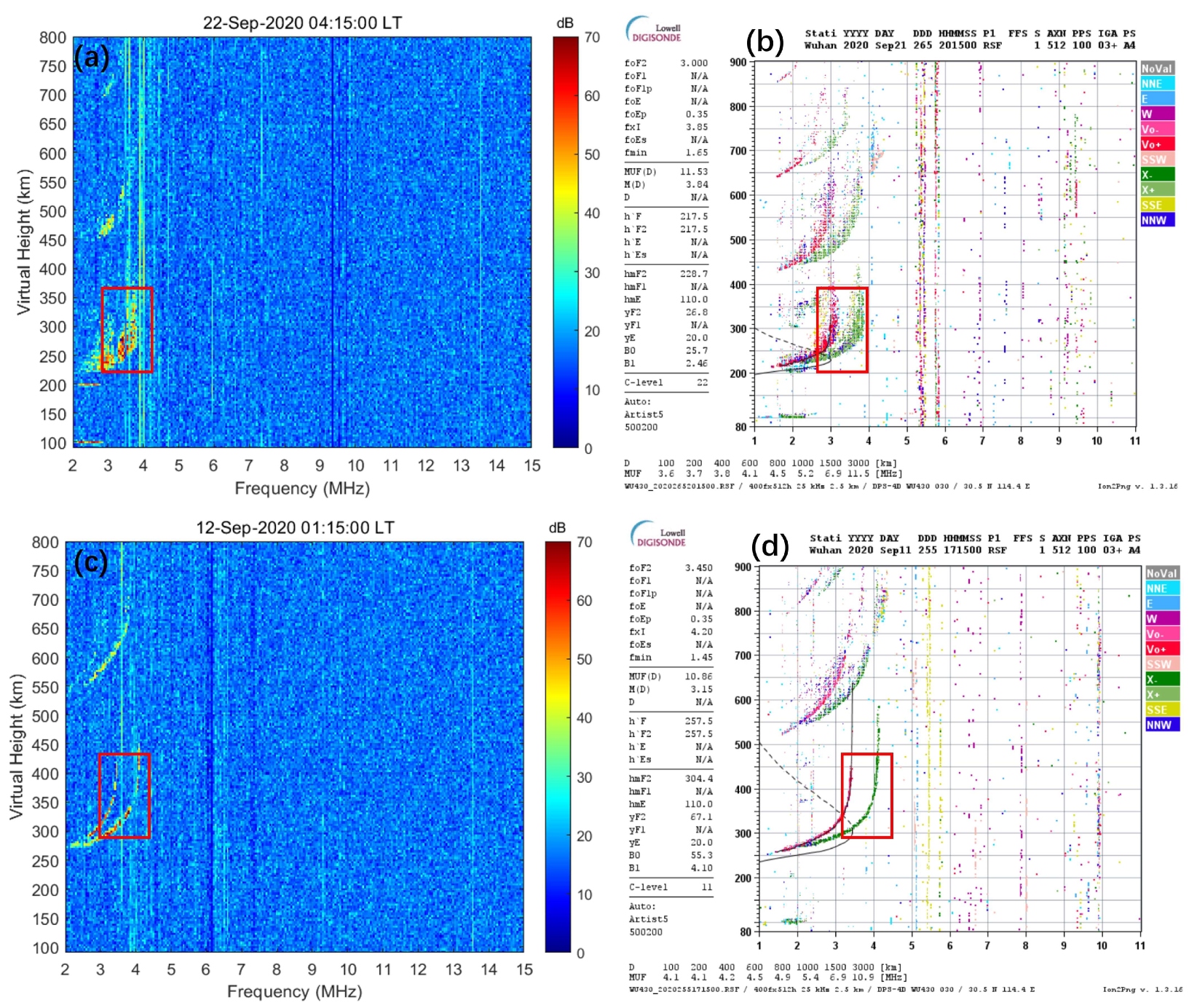

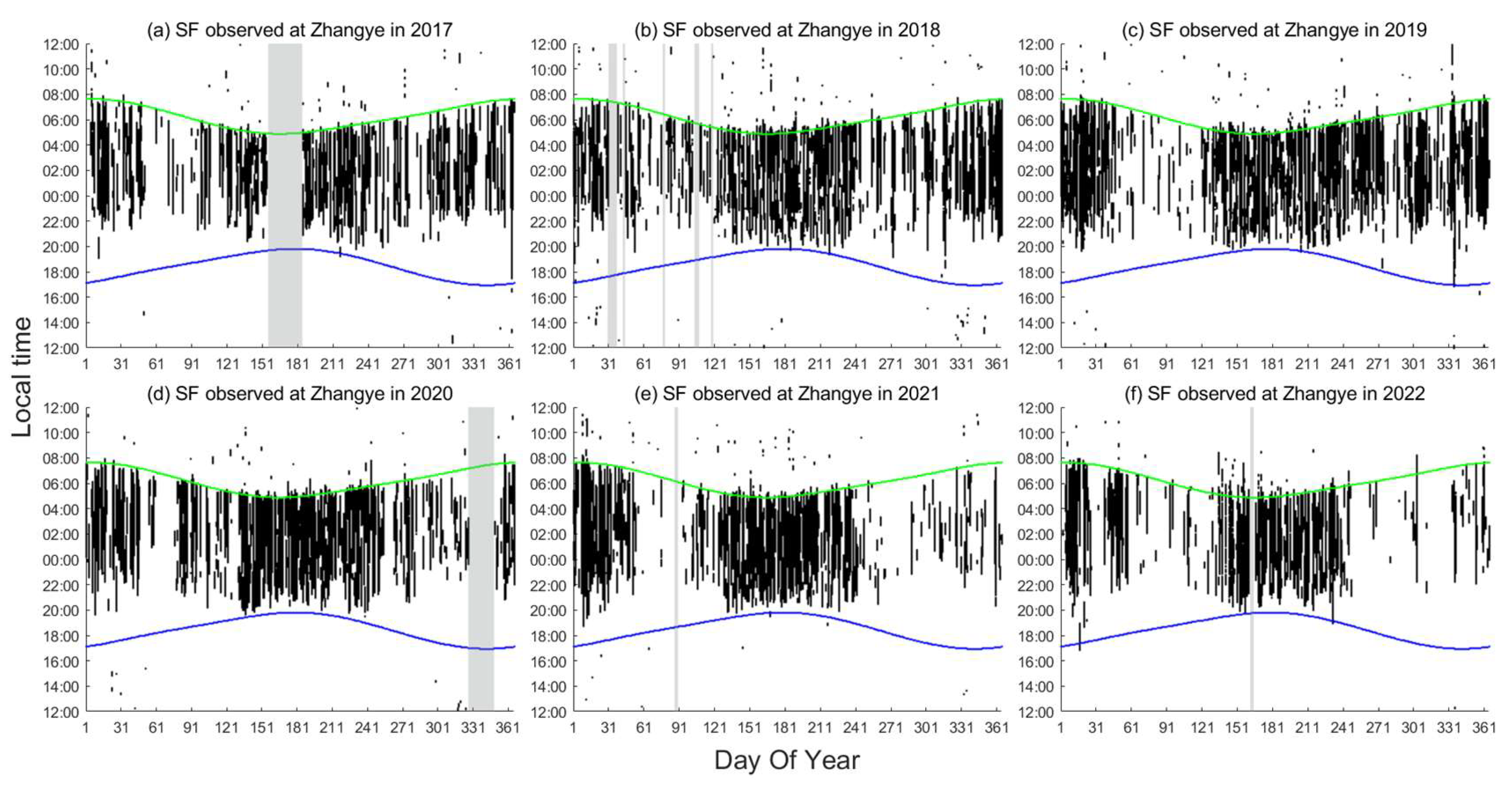
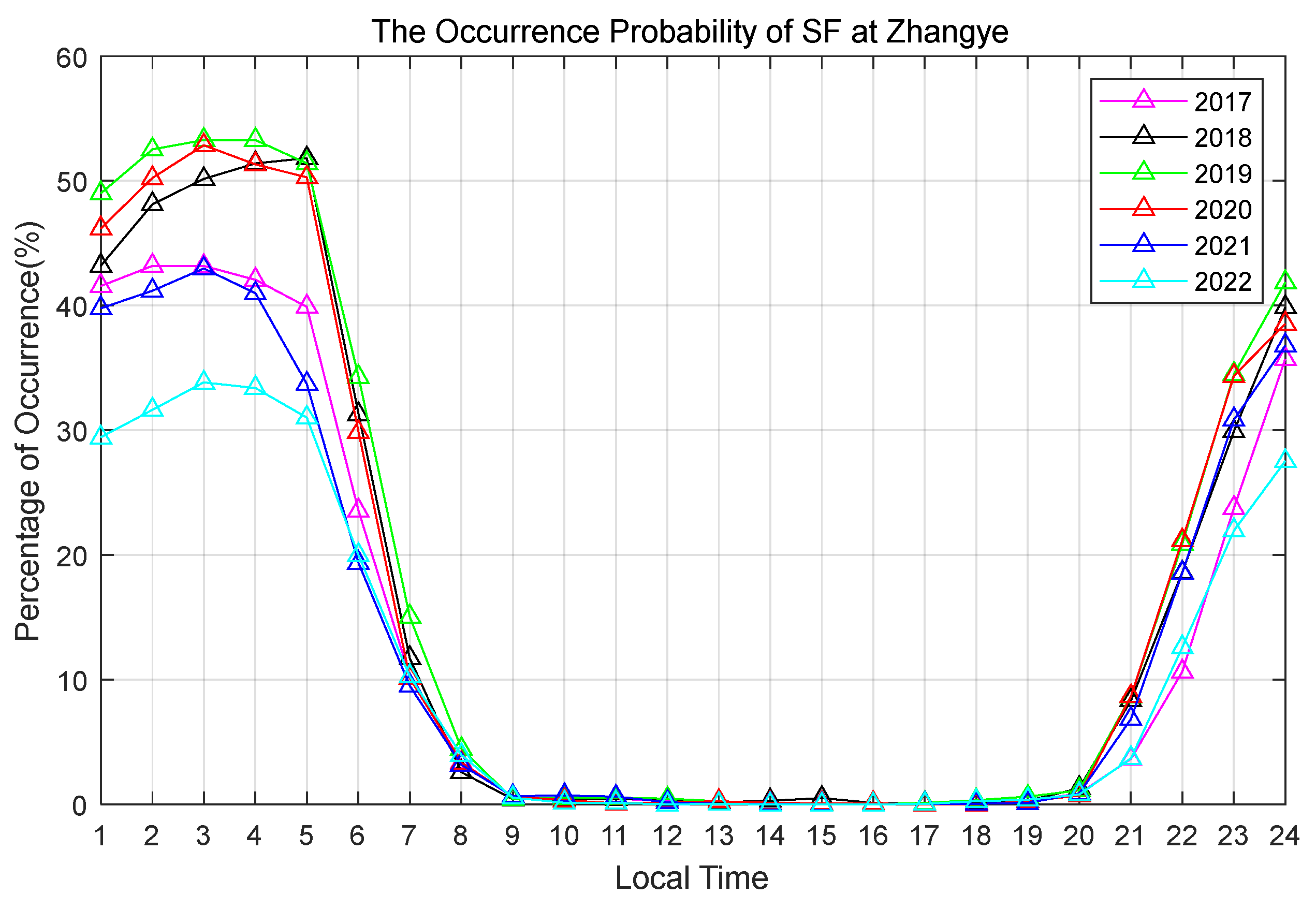
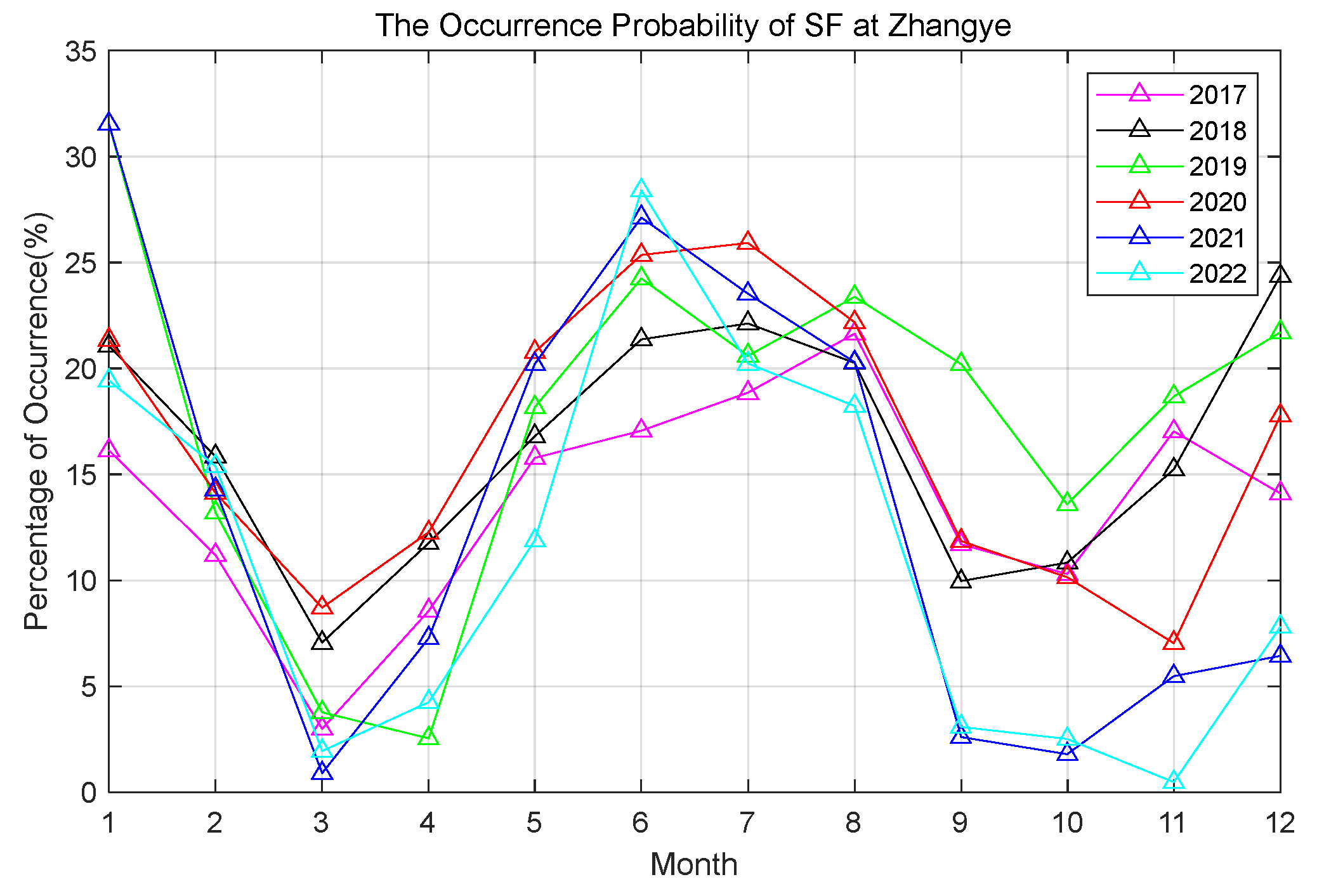

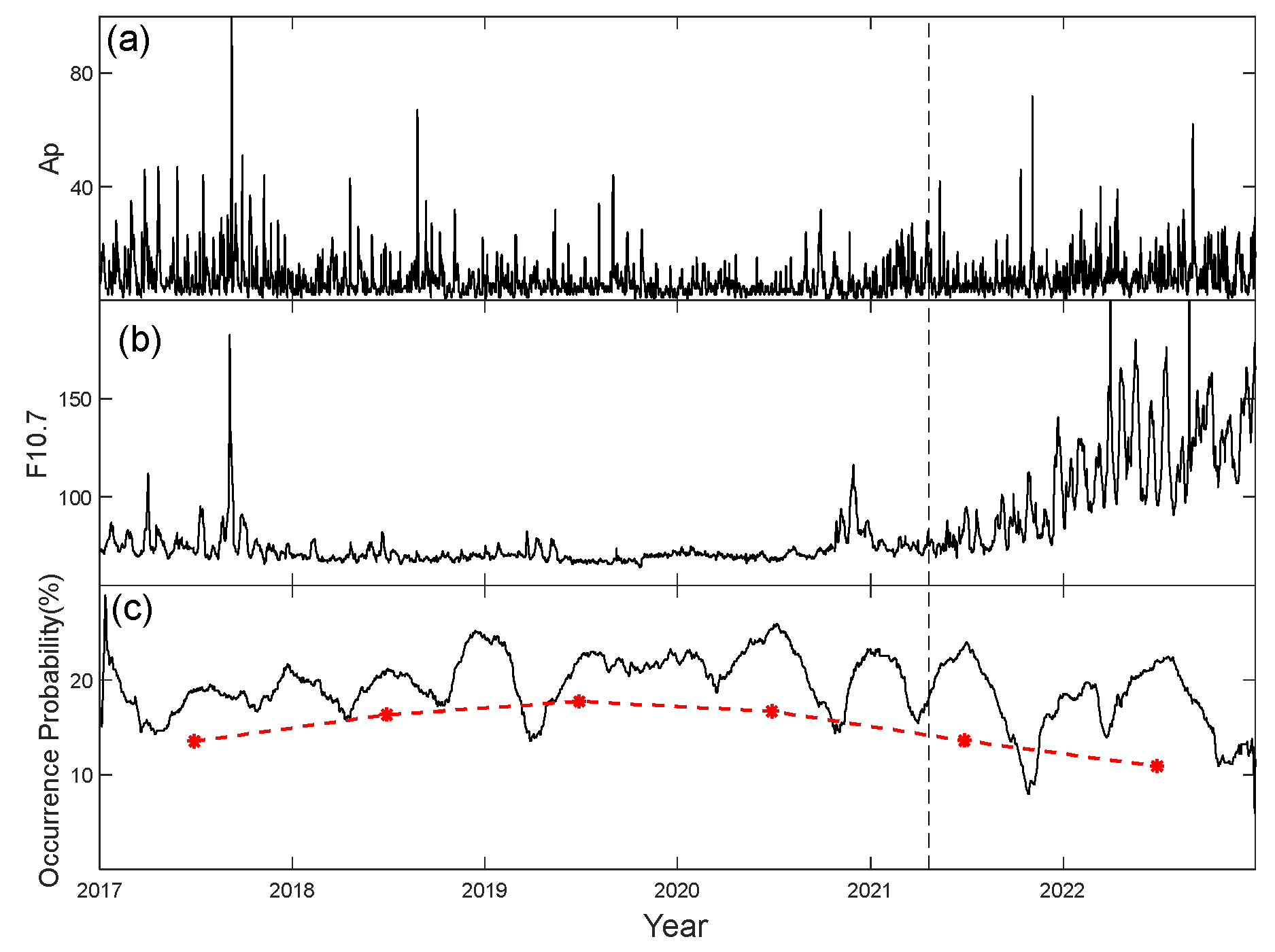


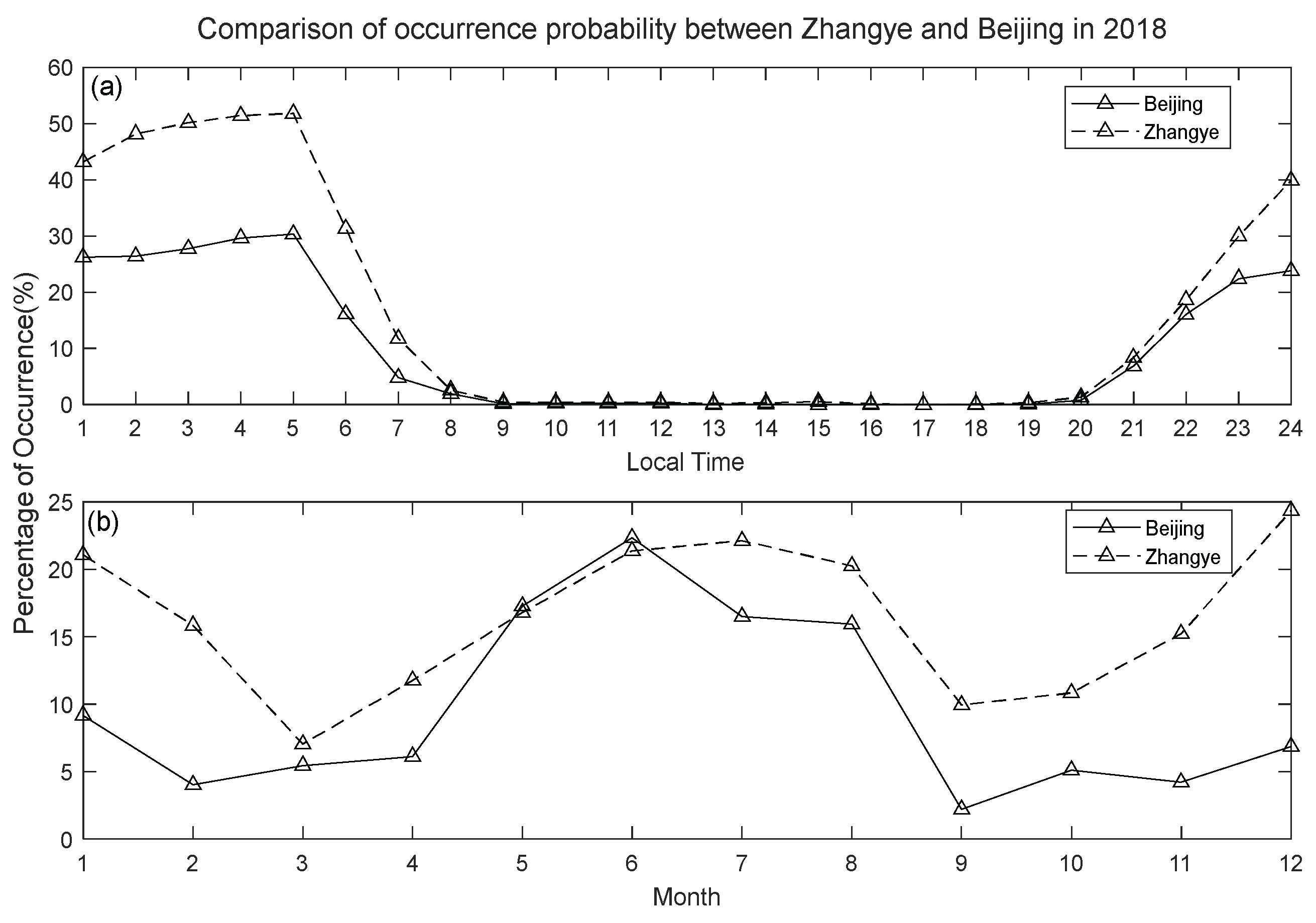


| Year | Number of Effective Days | Number of Missing Days | Specific Date of the Missing Data (Day/Month) |
|---|---|---|---|
| 2017 | 335 | 30 | 5 June–6 July |
| 2018 | 343 | 22 | 1 February–7 February; 9 February; 12 February–14 February; 18 March–20 March; 14 April–18 April; 28 April–30 April |
| 2019 | 365 | 0 | |
| 2020 | 343 | 23 | 22 November–14 December |
| 2021 | 361 | 4 | 28 March–31 March |
| 2022 | 360 | 5 | 11 June–15 June |
Disclaimer/Publisher’s Note: The statements, opinions and data contained in all publications are solely those of the individual author(s) and contributor(s) and not of MDPI and/or the editor(s). MDPI and/or the editor(s) disclaim responsibility for any injury to people or property resulting from any ideas, methods, instructions or products referred to in the content. |
© 2024 by the authors. Licensee MDPI, Basel, Switzerland. This article is an open access article distributed under the terms and conditions of the Creative Commons Attribution (CC BY) license (https://creativecommons.org/licenses/by/4.0/).
Share and Cite
Liu, Z.; Jiang, C.; Liu, T.; Wei, L.; Yang, G.; Shen, H.; Huang, W.; Zhao, Z. Statistical Characteristics of Spread F in the Northeastern Edge of the Qinghai-Tibet Plateau during 2017–2022. Remote Sens. 2024, 16, 1142. https://doi.org/10.3390/rs16071142
Liu Z, Jiang C, Liu T, Wei L, Yang G, Shen H, Huang W, Zhao Z. Statistical Characteristics of Spread F in the Northeastern Edge of the Qinghai-Tibet Plateau during 2017–2022. Remote Sensing. 2024; 16(7):1142. https://doi.org/10.3390/rs16071142
Chicago/Turabian StyleLiu, Zhichao, Chunhua Jiang, Tongxin Liu, Lehui Wei, Guobin Yang, Hua Shen, Wengeng Huang, and Zhengyu Zhao. 2024. "Statistical Characteristics of Spread F in the Northeastern Edge of the Qinghai-Tibet Plateau during 2017–2022" Remote Sensing 16, no. 7: 1142. https://doi.org/10.3390/rs16071142





